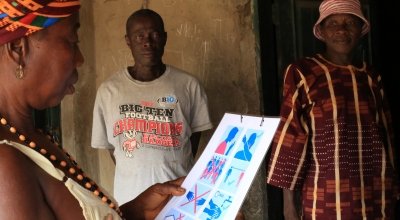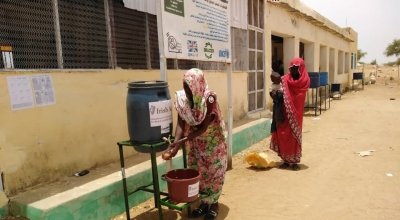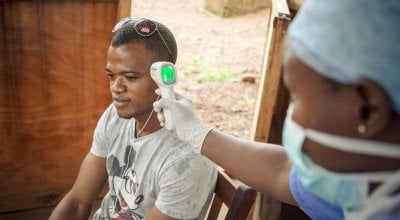
Read our 2023 annual report

Knowledge Hub
In the last month alone, floods in Somalia have displaced tens of thousands of people. They are the latest in a series of crises which threaten the lives of Somali people.
Massive swarms of locusts and COVID-19 have both come hot on the heels of severe drought in 2019 and these disasters are unfolding against the backdrop of a decades-long conflict, adding layers of complexity to an ongoing cycle of crisis.
Frequent flooding
Since late June, nearly 200,000 thousand people have been affected by flooding in Somalia. Over 100,000 hectares of farmland have been destroyed, 100 villages are still under water and tens of thousands of people have been displaced. It is, by all means, a significant emergency in its own right.
Unfortunately, for the people of Somalia, it is not the biggest crisis they face.
Floods are, sadly, a regular occurrence for communities living along the Jubba and Shabelle river basins. They are a devastating by-product of the double-edged sword that are the Gu Rains, which fall from April to June. Too little rain and farmers find themselves in a drought situation. Too much, and crops are destroyed by flooding. It is a precarious line for farmers to tread.
In May, our teams responded to floods that affected half a million people and forced 250,000 to flee their homes. This week, we are mounting an emergency response to flooding in Afgooye District in Lower Shabelle region, where 70,000 people have either been affected or are at risk of flash floods.
Our team supports flood-prone communities through a two-pronged approach. The pre-emptive work helps to mitigate risk by raising awareness amongst the communities and by sandbagging vulnerable spots along the riverbank to prevent it from bursting. In turn, our response work acts swiftly to provide affected families with unconditional cash transfers and to ensure access to safe clean water, sanitation and hygiene.
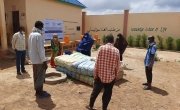
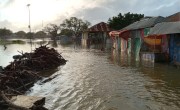
Locusts devouring crops
This year, however, the rains bring an even bigger threat. Rains provide favourable conditions for new generations of locusts to hatch and thrive. The threat posed by the locusts is so large that the government declared a national emergency back in February, when large swarms moved across the country devouring crops. It is the worst locust invasion that Somalia has experienced in 25 years.
As of March this year, locusts had damaged more than 25,000km of pastoral land and now, as the fourth generation of this infestation has hatched, it is anticipated that 3.5 million people will not have enough food to eat between now and the end of this year.

Global pandemic
Somalia already had enough to grapple with when the World Health Organisation declared a pandemic on March 11 of this year. Just five days later, the first confirmed case of COVID-19 in the country was announced and brought a myriad of new and complex challenges for the Somali people.
The most obvious challenge is the capacity of the Somali healthcare system to treat people who become infected. The system has been persistently weakened and eroded by decades of violence and insecurity and as a result, there are only 15 ICU beds in the entire country to serve a population that conservative estimates say is 15 million people. Somalia is ranked 194 out of 195 on the Global Health Security Index so the outlook for its ability to cope with this deadly new virus was not good.
So far, the pandemic has not had as devastating an impact on Somalia as first predicted. As of August 5, there are 3,220 confirmed cases in Somalia with 93 confirmed deaths.
It is not clear why the number of cases remains low but one likely explanation is that there is limited capacity to carry out testing and many cases are going undetected. Also, 70% of the population is aged below 30, making it less likely that they would be severely affected and seek testing.
Secondary deaths
However, there is a real fear that this virus will lead to an increase in secondary deaths. It is vital that all available health facilities are kept open and safe for people to visit.
Concern runs a number of health facilities and mobile clinics in Somalia and our teams have gone to great lengths in order to keep those in operation and continue our health support to vulnerable communities. We have trained staff, set up triage facilities, supplied PPE and increased hand-washing facilities. In order to tackle malnutrition specifically, our teams have pre-positioned extra supplies of the therapeutic food that is used to treat malnourished children to ensure continued supplies.
The pandemic has meant that staff have had to work harder than ever, extending their working hours to adapt to new social distancing regulations.
Andrea Solomon, Programme Director for Concern in Somalia, explains that extra support has also been put in place for healthcare workers who have found themselves with a heavy burden to bear.
“We're providing front-line healthcare staff with psycho-social support in recognition of the fact that their jobs are very difficult at the best of times and now they have to cope with the impact of COVID-19 as well.”

Economic turmoil
The particularly brutal aspect of the COVID-19 crisis is that as it restricts capacity to address rising levels of hunger, it is also contributing to the problem. The economic impacts of the pandemic, both global and local, are set to make their mark, according to Abdi-Rashid Haji Nur, Concern’s Country Director in Somalia.
“The pandemic will certainly worsen food insecurity. It will impact the domestic food market supply chains, income sources, and will limit employment opportunities. Remittances, which have been a lifeline for so many households in Somalia over the years will be hit badly as the economies of source countries continue to shrink.”
The loss of remittances alone will be a huge blow to the country. Estimates vary, but they are thought to account for as much as $2 billion each year, exceeding the amount of money that goes in by humanitarian aid, and supporting about 40% of the population.
And it’s not just money coming in that’s affected, it is also trade flowing out.
For example, livestock is one of Somalia’s biggest exports. The FAO estimates that it accounts for roughly 40% of Somalia’s GDP and involves as much as 60% of the workforce. With the largest markets in the Middle East, the annual pilgrimage to Mecca (Hajj) is a key trading event in every cattle farmer’s calendar. With the event cancelled this year, farmers have been left scrambling to find markets for their livestock.
As the consequences of the pandemic have started to hit, our teams have been ramping up their support. Between March and May of this year, they reached an additional 12,500 vulnerable households with cash transfers that will enable them to buy the food and essential items they need to survive this crisis.
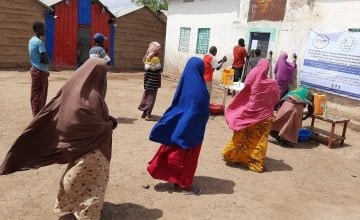
The problem of social distancing
As the government and aid agencies grapple with health and economic challenges, the Somali people are also grappling with the new restrictive measures that have been put in place for their safety.
The uptake of social distancing has not been widespread due to a range of reasons, some of them relating to culture and the prevalence of hand-shaking and hugging in Somali culture. Others run even deeper.
“With a poverty rate of 69%, the majority of people cannot afford to stay at home and wait for a solution. Even more so the half a million displaced people in Mogadishu living in camps. They have no choice but to be out every day to feed their families,” explains Abdi Rashid Haji Nur.
They would rather risk going outside and catching the virus than staying at home and starving to death.
He feels this has created a sense that COVID-19 is somehow normal and just another challenge for people to face. He stresses the need to address this because “COVID-19 is not and will not be normal”.
Concern has been engaging heavily in awareness raising campaigns that might gradually help in changing those behaviours. We have supported radio campaigns, and are working closely with artists, religious leaders and influential community members to look for ways to get the message through.
It is not an easy task, because looming over these efforts is another simple and heart-breaking fact.
People are much more afraid of dying from bullets and bombs than they are of COVID-19.
Decades of conflict
The people of Somalia have been plagued by the violence and brutality of conflict for three decades now. It is the crisis that arches over all the others and it is conflict that has weakened the health system to the level that it is at today. Indeed, it has weakened the state to such an extent that huge portions of the country are not under government control.
This means that government and humanitarian response to crises such as droughts, locusts or COVID-19 will never reach much of the population – and it makes gaining access to other regions both difficult and dangerous, as Abdi Rashid Haji-Nur explains.
“Operationally, it is difficult for national and international humanitarian agencies to deliver services to people in the different parts of the country. As long as there is absence of efforts to contain and to deescalate those tensions and conflicts, we will be having challenges in terms of having access.”
Making matters worse is the potential that other crises have to exacerbate tensions within the country.
The effects of the pandemic, or the locust infestation, or the effects of climate change like flooding or drought … You name it, one after the other, they're all enough to intensify conflicts over resources and power within the country.
Put simply, it is a vicious cycle of crisis and violence within Somalia. Conflict complicates efforts to adequately respond to COVID-19, swarms of locusts or climate crises, and in turn, each of those crises can exacerbate conflict.
Progress is possible
It is a situation that seems very bleak. But we must not forget that progress is possible. Our teams have done amazing work for decades and have seen for themselves the difference that can be made. And we’ve seen what’s possible through collective action when aid agencies, the government, diaspora and the affected communities themselves worked together helped to avert famine in 2017.
There is much that needs to be tackled, and limiting the spread and impact of COVID-19 is chief amongst them.
You can support our COVID-19 response around the world by donating today.
Our impact in 2023
people reached through our emergency response
people reached through our health interventions
people reached through our livelihoods programmes



